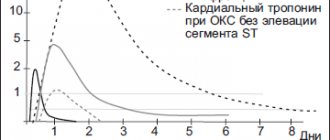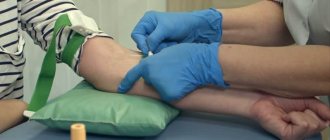More than eight million people die from cancer every year around the world. This is 13 percent of the total number of deaths on the planet. Oncologists say that the greatest danger of cancer lies not even in themselves, but in late diagnosis.
Often, oncological processes in the body occur secretly, without external manifestations, and the patient does not suspect anything until the disease reaches a late stage. At this stage, treatment is no longer effective, which explains the high mortality rate from this group of pathologies.
Early diagnosis of cancer is the main goal of modern medicine. But there are no accessible and accurate rapid tests. Therefore, it is very important to be attentive to indirect signs that may indicate the development of cancer.
Analysis of urine
Cancer of the urinary system manifests itself as blood in the urine.
Urine may also contain ketone bodies, which indicate tissue breakdown. However, these symptoms also accompany diseases not related to oncology, for example, they indicate the presence of stones in the bladder or kidneys, or diabetes mellitus. For diagnosing other types of cancer, urine analysis is not informative. It cannot be used to judge the presence of cancer, but deviations from the norm indicate health problems. If the deviations are serious and confirmed by the results of other basic tests, then this is a reason to conduct special tests to determine cancer.
The exception is multiple myeloma, in which specific Bence Jones protein is determined in the urine.
For the study, morning urine is collected in a sterile container, which can be purchased at a pharmacy. You need to take a shower first.
Stool analysis
Blood may also be present in the stool, and it is almost impossible to notice it visually. Laboratory analysis will help determine its presence.
The presence of blood in the stool is a sign of intestinal cancer (most often colon), but it is also a symptom of many benign gastrointestinal diseases. Polyps in the intestines can bleed. Moreover, it should be remembered that polyps tend to degenerate into a malignant tumor. In any case, the presence of blood in the stool is a reason to undergo a more in-depth diagnosis and take tests to detect cancer.
Feces are also collected in a sterile container in the morning.
What blood test shows cancer?
Many patients are convinced that it is possible to detect cancer using a blood test. In fact, there are several types of this diagnostic procedure, starting with a general analysis and ending with an analysis for tumor markers. The following types of cancer diagnosis using blood tests with varying degrees of information content are distinguished:
- general analysis;
- biochemical analysis;
- blood clotting test;
- immunological blood test (for tumor markers).
Even if cancer has not yet manifested itself with painful symptoms, negative changes are already occurring in the body, which can be recorded by a blood test. When a malignant tumor grows, it destroys healthy cells that help the body grow and releases toxic substances. These changes are noticeable even with a general blood test, but they can also be a sign of dozens of diseases not related to cancer.
The most informative is considered to be an analysis of tumor markers - specific substances that are released into the blood as a result of the vital activity of tumor cells. However, given that tumor markers are contained in the body of any person, and their number increases during inflammation, this analysis does not 100% prove the presence of cancer. It only becomes a reason to undergo more reliable tests to determine oncology.
Preparation for tumor marker analysis
In order for the test results to be accurate, you should donate blood for tumor markers on an empty stomach. It's best to do this in the morning. If it doesn’t work out in the morning, then you should plan so that before donating blood for analysis, do not eat or drink anything other than water for at least 8 hours.
You should not drink alcohol on the eve of the test. It is advisable not to smoke for an hour before the test.
Patients who have undergone radical treatment are strongly recommended to be tested for tumor markers every 3-4 months.
Sign up for diagnostics Do not self-medicate. Contact our specialists who will correctly diagnose and prescribe treatment.
Will a general blood test show cancer?
This analysis does not provide complete information about the presence of a tumor in the body. However, this is one of the basic tests that helps detect cancer at an early stage, when it does not yet manifest symptoms. Therefore, if you decide which tests to take to check for cancer, then you need to start with it.
The following changes in the structure of the blood may indicate malignant processes in the body:
- decrease in the number of lymphocytes;
- increase or decrease in the number of leukocytes;
- decrease in hemoglobin;
- low platelets;
- increased erythrocyte sedimentation rate (ESR);
- increase in the number of neutrophils;
- presence of immature blood cells.
If a patient, in the presence of one or several of the listed signs at the same time, experiences weakness, quickly gets tired, loses appetite and weight, it is necessary to undergo a more detailed examination.
Blood is donated on an empty stomach or at least 4 hours after eating. The sampling is carried out using a finger.
Clinical blood test indicators for oncology
A clinical blood test allows you to conduct research on six indicators. Each of them, in case of deviation from the norm, indicates certain malfunctions in the functioning of vital systems.
Let's take a closer look at the indicators of a general blood test that may go beyond the normal range for cancer.
Hemoglobin
Hemoglobin is a complex protein that binds to oxygen and transports it to tissues. In the blood, hemoglobin is a component of red blood cells. Normal hemoglobin levels in adults look like this:
| Category of people | Hemoglobin norm |
| Women | 120-150 g/l |
| Men | 130-160 g/l |
With oncological pathologies, the level of hemoglobin in the blood decreases. Anemia or low hemoglobin levels are observed with tumors of internal organs with concomitant damage to the hematopoietic system. There are four main causes of anemia in oncology:
- problems with iron absorption;
- metastases in the bone marrow that block the production of hemoglobin;
- intoxication of the body;
- malnutrition without the proper amount of iron.
Leukocytes
Leukocytes are white blood cells that are normally present in the blood at a concentration of 4-9*109/l. These particles perform the body’s protective function against foreign antigens. With cancer, the level of white blood cells may increase or decrease.
Elevated white blood cells are observed in leukemia and cancer of any location. But leukocytosis is a nonspecific indicator. There are many factors for its development, and oncology is only one of them.
The cause of a reduced level of white blood cells (leukopenia) among cancer diseases can be:
- acute leukemia,
- metastases of neoplasms in the bone marrow,
- myelofibrosis,
- plasmacytoma.
It is believed that the leukocyte count is the main tumor marker in a general blood test. In case of serious deviations from the norm, a more in-depth examination is necessary.
Erythrocyte sedimentation rate (ESR)
ESR is an indicator that shows the rate of erythrocyte sedimentation under the influence of gravity. Normally, the ESR is:
| Category of people | ESR norm |
| Newborns | 0-2 mm/h |
| Children under six years old | 12-17 mm/h |
| Men under 60 years of age | no more than eight mm/h |
| Women under 60 years of age | no more than 12 mm/h |
| Men over 60 years of age | no more than 15 mm/h |
| Women over 60 years old | no more than 20 mm/h |
A cause for concern is an ESR exceeding the norm by three to five times. In terms of oncological problems, it may indicate malignant tumors localized in any organ, as well as blood oncology.
Platelets
Platelets are nuclear-free blood elements that are responsible for two important functions:
- closing the site of vessel damage by forming a primary plug (blood clotting);
- acceleration of plasma coagulation reactions.
Platelet standards depend on the age and gender of the person:
| Category of people | Platelet rate |
| Newborns | 100,000-420,000 U/µl |
| Children under one year old | 150,000-350,000 U/µl |
| Children from one to five years old | 180,000-380,000 U/µl |
| Children from five to seven years old | 180,000-450,000 U/µl |
| Men | 200,000-400,000 U/µl |
| Women | 180,000-320,000 U/µl |
Deviations from the norm of platelets are dangerous both in the direction of decrease and in the direction of increase. Thrombocytopenia (a decrease in platelet count below 100,000 U/μl) is characteristic of leukemia, and thrombocytosis (an increase in the rate in adults above 400,000 U/l) is characteristic of cancer pathologies of any location.
Blood chemistry
The method identifies abnormalities that may be a sign of cancer. It should be taken into account that the same changes are characteristic of many non-oncological diseases, so the results cannot be interpreted unambiguously.
The doctor analyzes the following indicators:
- Total protein. Cancer cells feed on protein, and if the patient has no appetite, then its volume is significantly reduced. In some cancers, the volume of protein, on the contrary, increases.
- Urea, creatinine. Their increase is a sign of poor kidney function or intoxication, in which protein in the body is actively breaking down.
- Sugar. Many malignant tumors (sarcoma, cancer of the lung, liver, uterus, breast) are accompanied by signs of diabetes mellitus with changes in blood sugar levels, since the body does not produce insulin well.
- Bilirubin. An increase in its volume may be a symptom of malignant liver damage.
- Enzymes ALT, AST. Increased volume is evidence of a possible liver tumor.
- Alkaline phosphatase. Another enzyme, an increase in which may be a sign of malignant changes in bones and bone tissue, gall bladder, liver, ovaries, and uterus.
- Cholesterol. With a significant decrease in volume, liver cancer or metastases to this organ may be suspected.
Blood is drawn from a vein. It must be taken on an empty stomach.
Immunological blood test: tumor markers
If we talk about what tests show oncology, then this examination is quite informative and allows you to determine the presence of cancer. It is also used to detect relapses after treatment.
Tumor markers are special types of protein, enzymes, or protein breakdown products. They are released either by malignant tissue or by healthy tissue in response to cancer cells. Now the existence of more than 200 species has been scientifically proven.
Tumor markers are also present in small quantities in the body of a healthy person; their volume increases moderately, for example, with a cold, as well as in women during pregnancy, and in men with prostate adenoma. However, the appearance of certain specific types in large quantities is characteristic of certain tumors. For example, tumor markers CEA and CA-15-3 can signal breast cancer, and CA 125 and HE-4 can signal ovarian cancer. To obtain the most objective result, it is recommended to be tested for several tumor markers.
By increasing the level of a particular tumor marker, it is possible to determine which organ or system is affected by the tumor. Also, this analysis can show that a person is at risk of developing cancer. For example, in men, an increase in the PSA tumor marker becomes a precursor to prostate cancer.
An immunological test is taken on an empty stomach, blood is taken from a vein. Tumor markers are also determined by urine analysis.
Timely help is the key to successful recovery
By consulting a doctor in time, you can successfully resolve the problem and get rid of the disease. Oncology specialists are ready to help you. Doctors note that children’s bodies tolerate chemotherapy better and it is easier for them to recover after all procedures, which increases the chances of recovery.
The center's oncologists will advise, provide timely assistance, and select the correct course of treatment. The medical staff will find an approach to the child and help him quickly rehabilitate after the course of treatment.
Among the main advantages of oncological treatment it is necessary to highlight:
- world standards of treatment;
- increased life expectancy after diagnosis;
- social adaptation;
- rehabilitation.
When the first signs appear, you cannot do without the help of a qualified doctor. He will help determine the stage of cancer, the size of the tumor, advise parents, prescribe an examination, and conduct treatment. The entire course of treatment takes place under the strict supervision of doctors; the center has all the necessary conditions for this. You can make an appointment with a pediatric oncologist by calling the phone number listed on the website. You can also order a call back or use the form on the website by sending a request to a center specialist.
Cytological examination
This is the most informative type of laboratory examination, which accurately determines the presence or absence of malignant cells.
The analysis consists of taking a tiny section of tissue in which the presence of a cancerous tumor is suspected, with further examination under a microscope. Modern endoscopic technologies make it possible to collect biomaterial from any organ - skin, liver, lungs, bone marrow, lymph nodes.
Cytology is the study of cellular structure and function. The cells of a cancerous tumor differ significantly from the cells of healthy tissues, so laboratory testing can accurately determine the malignancy of the neoplasm.
The following biomaterials are used for cytological examination:
- imprints from the skin, mucous membranes;
- liquids in the form of urine, sputum;
- swabs from internal organs obtained during endoscopy;
- tissue samples obtained by puncture with a thin needle.
This diagnostic method is used for preventive examinations, clarifying the diagnosis, planning and monitoring treatment, and identifying relapses. It is simple, safe for the patient, and results can be obtained within 24 hours.
Instrumental diagnostics
If a cancer is suspected or a malignant neoplasm is detected, the patient must undergo more detailed examinations to determine the location of the tumor, its volume, the extent of damage to other organs and systems (the presence of metastases), and also to develop an effective treatment program. For this purpose, a complex of instrumental examinations is used. It includes various types of diagnostics, depending on the suspicion of a particular disease.
Modern clinics offer the following types of instrumental examinations:
- magnetic resonance imaging (with or without contrast agent);
- computed tomography (with and without the use of X-ray contrast agent);
- plain radiography in frontal and lateral projection;
- contrast radiography (irrigography, hysterosalpingography);
- ultrasound examination with Dopplerography;
- endoscopic examination (fibrogastroscopy, colonoscopy, bronchoscopy);
- radionuclide diagnostics (scintigraphy and positron emission tomography combined with computed tomography).
These types of examinations make it possible to detect cancer with high accuracy.
By the way
Fecal occult blood test.
“This test is used to diagnose colon cancer,” says oncologist at the Atlas clinic network, candidate of medical sciences Maxim Ignatov . – However, this study is not specific. Blood in the stool can also appear in other diseases of the gastrointestinal tract - polyps, hemorrhoids, stomach and duodenal ulcers, infectious bowel diseases, etc. If a malignant neoplasm is suspected, the patient is referred for a colonoscopy.






